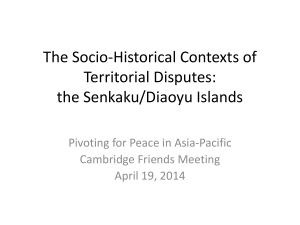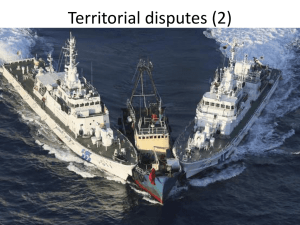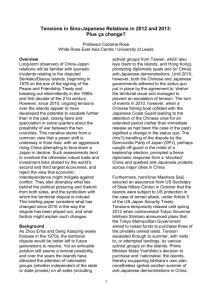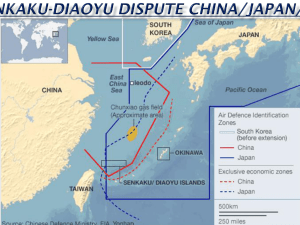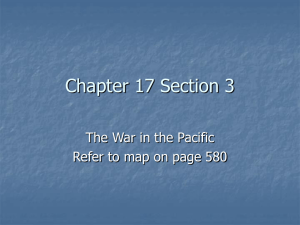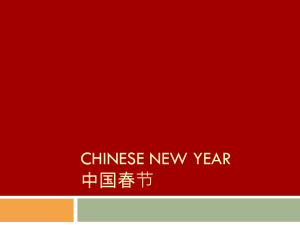PowerPoint 演示文稿 - University of Nottingham
advertisement
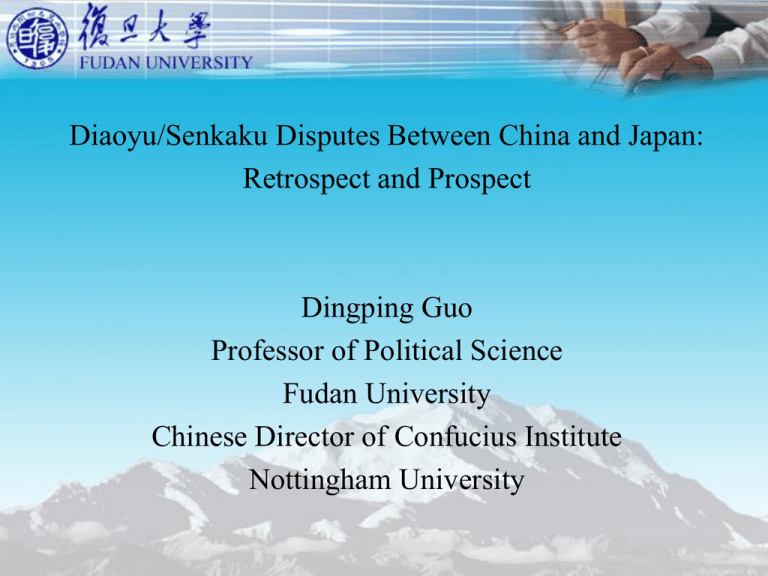
Diaoyu/Senkaku Disputes Between China and Japan: Retrospect and Prospect Dingping Guo Professor of Political Science Fudan University Chinese Director of Confucius Institute Nottingham University Outline of Presentation First, historical origins of Diaoyu/Senkaku disputes through some official documents Second, the root causes of the “purchase” decision by Japanese government. Third, the three scenarios of the Diaoyu/Senkaku disputes in particular and Sino-Japanese relations in general Historical origins of Diaoyu/Senkaku disputes through official documents Geographically, Diaoyu islands are located at the northeast of Taiwan and on the voyage from China to the Ryukyu Kingdom that was annexed by Japan in 1879 and renamed Okinawa afterwards. Historical origins of Diaoyu/Senkaku disputes through official documents According to Chinese sources the first mention of the Diaoyu islands is in a 15th-century document now held at the Bodleian Library in Oxford. Early sources tended to mention only the islands’location on the voyage to the Ryukyus from China By the 17th century Chinese sources clearly named the maritime boundary between the Diaoyu islands and the Ryukyus as the Heishuigou (‘Black Water Trench’), an area of high turbulence which we now know marks the edge of the continental shelf Historical origins of Diaoyu/Senkaku disputes through official documents In 1720 Xu Baoguang, the deputy Chinese ambassador sent to confer the royal title upon the Ryukyuan king, collaborated with the local scholars to compile the travelogue Zhongshan Chuanxin lu (Record of the Mission to Zhongshan), which demarcated the westernmost border of the Ryukyuan kingdom at Kume-jima south of the Heishuigou Trench. Deputy ambassador Zhou Huang identified Heishuigou as the boundary in 1756. Historical origins of Diaoyu/Senkaku disputes through official documents Record of Missions to Taiwan Waters (1722), Gazetteer of Kavalan County (1852), and Pictorial Treatise of Taiwan Proper (1872). National Palace Museum, Taipei, Taiwan. Historical origins of Diaoyu/Senkaku disputes through official documents Qing period (1644-1911) records substantiate Chinese ownership of the Diaoyu Islands prior to 1895. Envoy documents indicate that the islands reside inside the “border that separates Chinese and foreign lands.” And according to Taiwan gazetteers, “Diaoyu Island accommodates ten or more large ships” under the jurisdiction of Kavalan, Taiwan Historical origins of Diaoyu/Senkaku disputes through official documents Diaoyu Island is recorded under Kavalan, Taiwan in Revised Gazetteer of Fujian Province (1871) Historical origins of Diaoyu/Senkaku disputes through official documents The governor of Okinawa, Nishimura, reported to the Ministry of Home Affairs on September 26, 1885: “(Diaoyu) Island seems to be the same one as Diaoyutai, Huangweiyu, Chiweiyu mentioned in Zhongshan Chuanxin Lu (Record of the Mission to Zhongshan). It is not only acknowledged by Chinese ambassador sent to confer the royal title upon the Ryukyuan king, but also given a official name and placed a national marker.” From Japan National Archives No. 315 (September 26, 1885) Historical origin of Diaoyu/Senkaku disputes through official documents Shanghai Newspaper (Shen Bao) reported on September 6, 1885:“Recently Japanese people erected Japanese Flag on the islands at the Northeast of Taiwan and tried to occupied it.” Following the first on-site survey, in 1885, the Japanese foreign minister wrote, “Chinese newspapers have been reporting rumour of our intention of occupying islands belonging to China located next to Taiwan.… At this time, if we were to publicly place national markers, this must necessarily invite China’s suspicion.…” From Japan National Archives (November 21, 1885) Historical origin of Diaoyu/Senkaku disputes through official documents “Ever since the islands were investigated by Okinawa police agencies back in 1885, there have been no subsequent field surveys conducted,” the Okinawa governor wrote in 1894. Japan Diplomatic Records Office. Letter dated May 12, 1894 affirming that the Meiji government did not repeatedly investigate the disputed islands. Historical origin of Diaoyu/Senkaku disputes through official documents After a number of Chinese defeats in the first Sino-Japanese War (1894-1895), a report from Japan’s Home Ministry said “this matter involved negotiations with China… but the situation today is greatly different from back then.” The Meiji government, following a secret cabinet decision in early 1895, promptly incorporated the Diaoyu islands Historical origin of Diaoyu/Senkaku disputes through official documents China was forced to sign the Treaty of Shimonoseki in April 1895 and cede to Japan “the island of Formosa (Taiwan) together all islands appertaining or belonging to said island of Formosa.” The Diaoyu islands are part of Taiwan This is to say, Japan annexed the Diaoyu islands as the war booty. Historical origin of Diaoyu/Senkaku disputes through official documents In his biography, Koga Tatsushiro, the first Japanese citizen to lease the islands from the Meiji government, attributed Japan’s possession of the islands to “the gallant military victory of our Imperial forces.” Historical origin of Diaoyu/Senkaku disputes through official documents Japanese government claims to have “discovered” the islands, a terra nullius belonging to no one, in 1884. Even some Japanese scholars said it was not true based on their researches on the official documents and thought that Japanese government incorporated the Diaoyu islands as war spoils. Historical origin of Diaoyu/Senkaku disputes through official documents “Japan shall be stripped of all the islands in the Pacific which she has seized or occupied since the beginning of the first World War in 1914, and that all the territories Japan has stolen from the Chinese, such as Manchuria, Formosa, and The Pescadores, shall be restored to the Republic of China. Japan will also be expelled from all other territories which she has taken by violence and greed” The Cairo Declaration on November 27, 1943 Historical origin of Diaoyu/Senkaku disputes through official documents The Cairo Declaration is cited in Clause Eight (8) of the Potsdam Declaration in 1945 The Potsdam Declaration (26 Jul 1945) stipulated that: "(8) The terms of the Cairo Declaration shall be carried out AND Japanese sovereignty shall be limited to the islands of Honshu, Hokkaido, Kyushu, Shikoku and such minor islands as we determine." Root causes of the “purchase” decision by Japanese government Why the Japanese government made the decision to purchase and nationalize the Diaoyu/Senkaku islands in September 2012 can be explained as follows: First, the rise of right-wing politicians and conservative nationalism trying to gloss over Japanese war history and overturn the fundamental order after the Second World War. Root causes of the “purchase” decision by Japanese government Obviously, the former governor of Tokyo, an ultraconservative politician, Shintaro Ishihara’s campaign for the purchase of Diaoyu islands directly prompted Japanese government to take further steps. Democratic Party of Japan and its nationalist and conservative nature Root causes of the “purchase” decision by Japanese government Shinzo Abe is a right-wing nationalist. Throughout his political career, he has called for the overturning of Japan's post-war pacifist constitution. Abe has also shown a deep ambivalence about facing up to Japan's crimes against Korean and Chinese people during World War Two. He has denied that the Japanese military was involved in the coercion of hundreds of thousands of Korean and Chinese women to work as prostitutes in military brothels. He has openly questioned whether Japan should be defined as an "aggressor", and he has campaigned for the revision of school history books to give a more positive view of Japan's war-time role. Root causes of the “purchase” decision by Japanese government There are a series of defiantly nationalistic comments, including remarks critical of the United States, by close political associates of Prime Minister Shinzo Abe. The new NHK president Katsuto Momii said, Japan should not be singled out for forcing women to provide sexual services to Japanese soldiers during the war, and this things happened everywhere, and the United States military did the same. Root causes of the “purchase” decision by Japanese government The most provocative comments came from one of Abe allies, an ultraconservative writer, Naoki Hyakuta, who was appointed by the prime minister himself to the NHK governing board. Hyakuta said in a speech that the Tokyo war tribunal after the World War II was a means to cover up the genocide of American air raids on Tokyo and the atomic bombings of Hiroshima and Nagasaki. Root causes of the “purchase” decision by Japanese government Second, the rise of China and Japan’s concern about it While the proximate cause of Japan’s nationalization of the Diaoyu/Senkaku islands may have been a desire to preempt a nationalistic mayor, the context in which it took place suggests it had more to do with Japan’s concern about the future. Root causes of the “purchase” decision by Japanese government As China’s power has grown rapidly while Japan’s has declined, the policymakers in Tokyo would not continue to leave the question of sovereignty to future generations because they fear that China could someday decide the issue unilaterally through the use of force From Tokyo’s perspective, it was imperative to resolve the sovereignty dispute before China becomes too powerful. Root causes of the “purchase” decision by Japanese government Third, the United States strategy of rebalancing to the Asia-Pacific When the US reformulated its global strategy and placed more emphasis on the Pacific Asia, Japan has made full use of this opportunity to fortify itself as America’s petit partner in East Asia and stand up against China. Root causes of the “purchase” decision by Japanese government “Recognizing that America’s future prosperity and security are intertwined with the East Asia-Pacific region, President Barack Obama made a strategic commitment to rebalance our efforts and investments toward Asia. The United States will remain a strong, reliable, and active partner in the region and is investing diplomatic, public diplomacy, military, and assistance resources in a way that is commensurate with our comprehensive engagement.” The East Asia-Pacific Rebalance: Expanding U.S. Engagement BUREAU OF PUBLIC AFFAIRS December 16, 2013 Root causes of the “purchase” decision by Japanese government Sustaining U.S. Global Leadership: Priorities for 21st Century Defense (2012) notes that the United States "will of necessity rebalance toward the Asia-Pacific region" “As a Pacific nation that takes our Pacific partnership seriously, the United States will continue to build on our active and enduring presence.” – Secretary of State John Kerry Root causes of the “purchase” decision by Japanese government The rebalancing strategy has brought different reactions for the Asian countries. Obviously, Japan welcomes U.S. engagement in Asian affairs and takes it as an important external force to balance China’s rise Bringing the Diaoyu/Senkaku dispute to a head at this time was driven by Japanese right-wing nationalistic policymakers’ concern about China’s rise and their use of the US rebalancing strategy. Three scenarios of Diaoyu/Senkaku disputes between China and Japan Considering the complex nature of the Diaoyu/Senkaku disputes, the historical animosity between China and Japan, and the difficult security situation in East Asia, the following three scenarios should be taken into account during the short, mid and long term if we want to maintain peace, stability and growth in the region. Three scenarios of Diaoyu/Senkaku disputes between China and Japan First, a crisis management mechanism should be established between the military forces and maritime administrations jointly by China and Japan, so as to prevent the escalation of tensions, especially the breakout of an unintended war between the two countries. Three scenarios of Diaoyu/Senkaku disputes between China and Japan Second, wisdom and courage are needed from Chinese and Japanese leaders to put bilateral relations back on normal track and develop the mutually beneficial strategic partnership. In contrast with the uninhabited islands in East China Sea, there are more important and more strategic issues that need to be addressed by the leaders from China and Japan, such as FTA negotiations, climate change and environmental cooperation, and non-traditional security issues. Three scenarios of Diaoyu/Senkaku disputes between China and Japan Third, the real and ultimate resolution of the territorial dispute over Diaoyu/Senkaku islands will take a long time only after China, Japan and the US establish more balanced great triangular relations and substantial progress is made in regional cooperation and community-building in East Asia. Thank You !
